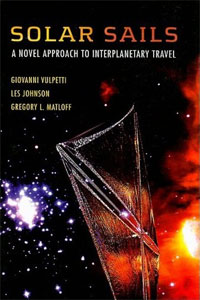Review: Solar Sailsby Jeff Foust
|
| The authors argue that a successful demonstration of a solar sail can open the door to its use on future operational missions that can either be performed more efficiently with solar sails or can only be flown with them. |
The result is a book that provides does provide a comprehensive yet readable overview of how solar sails work and how they could be used in the near future. Solar sails, for example, could provide stationkeeping for spacecraft at the Earth-Sun L1 point, eliminating the need for chemical propellants and their corresponding mass and limited lifetime. Their continuous thrust also allows for non-Keplerian orbits that can be used for “polesitting” spacecraft that can provide better communications coverage of the Earth’s poles.
So why aren’t solar sails already flying through the solar system? This question doesn’t get that much attention in the book, surprisingly enough, with only a little discussion of recent efforts and near-future plans near the end of the book’s third section. Some proposed missions involving solar sails, like NASA’s Space Technology 9, never got beyond the study stage; Cosmos 1, meanwhile, was built and launched in 2005, but failed to reach orbit because of a failure of its Russian launcher. Japan has tested solar sail deployment technologies on suborbital launches, but doesn’t seem to be in a hurry to deploy a full-fledged solar sail in orbit.
At least a partial answer to that question is tucked away in the back, when the book discusses another non-chemical propulsion system, ion engines, that has found greater acceptance. Ion engines won acceptance once NASA’s Deep Space 1 mission successfully demonstrated its use; that mission paved the way for its use on other missions, like the Dawn mission, where ion propulsion provided clear advantages over chemical propulsion. (Missing from this analysis is the relatively common use of smaller ion thrusters on commercial communications satellites, providing a more efficient alternative to stationkeeping than chemical thrusters.) The authors argue that a successful demonstration of a solar sail can open the door to its use on future operational missions that can either be performed more efficiently with solar sails or can only be flown with them. Until a space agency or private venture steps forward to demonstrate what solar sails are capable of, their promise will likely be contained to the pages of books like this one.
